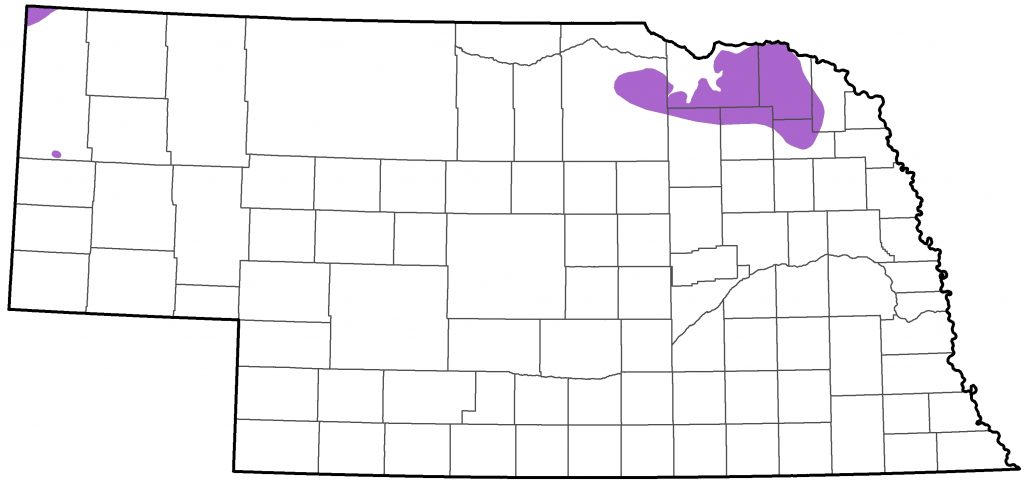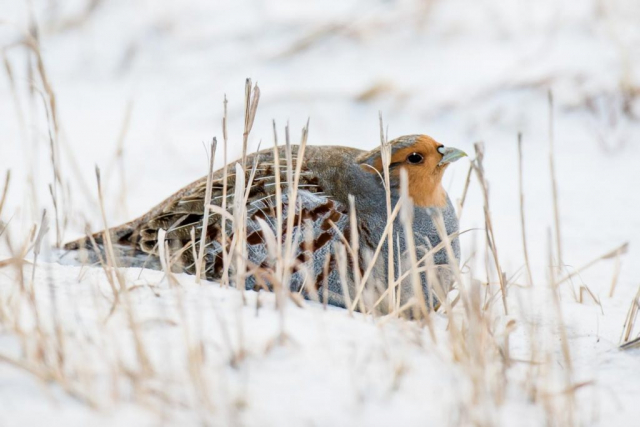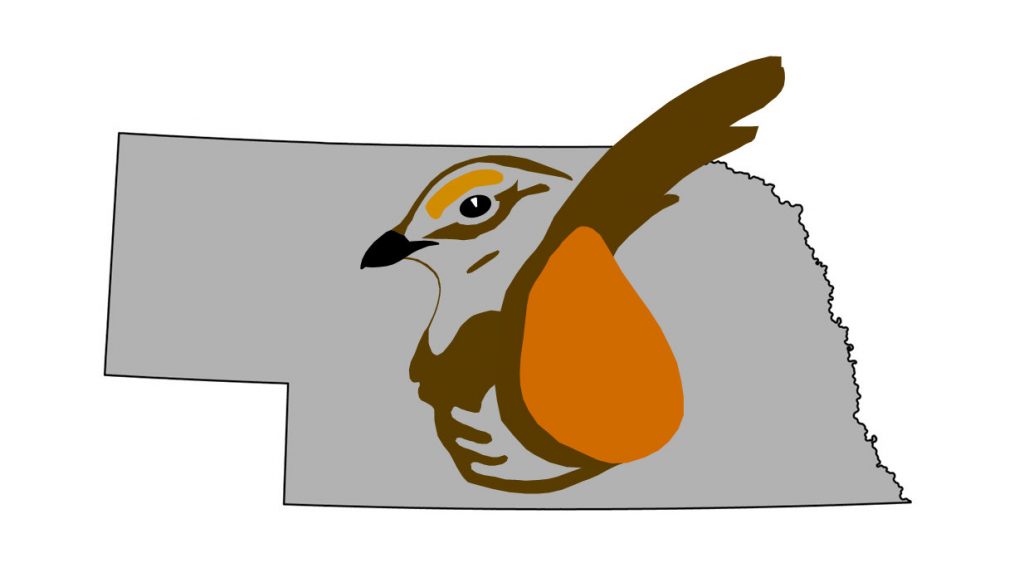Perdix perdix
Status: Introduced. Decreasing. Variably uncommon to rare regular resident northeast and north-central, locally rare Sioux and Scotts Bluff Cos.

Documentation: Specimen: WSC 683, Nov or Dec 1978 or 1979 Wayne Co.
Taxonomy: In its native Western Palearctic, eight subspecies are currently recognized (AviList 2025). North American introductions were of several subspecies and existing populations are considered of mixed derivation (AOU 1957), although most are probably of the European subspecies P. p. perdix (Carroll et al 2020).
Gray Partridges are also called Hungarian Partridges, or, colloquially, “Huns”.
Resident: The first population to become established, or at least augmented, was by natural expansion from South Dakota into the north-central part of the state (Carroll et al 2020, Vander Zouwen 1990), especially Boyd and northern Holt Cos (Mathisen and Mathisen 1960), and probably also Knox Co (Rapp et al 1958).
Several attempts had been made to establish this species in various parts of Nebraska, beginning as early as 1925-26, but none appeared to have been successful (Glandon 1936, Viehmeyer 1942, Mathisen and Mathisen 1960, Rosche 1982). However, Mathisen and Mathisen (1960) noted there had been recent sightings in Cedar Co, near Merriman in Cherry Co, and on the Niobrara River south of Gordon, and concluded that “It is likely that small, isolated colonies persist from Wayne County west to Crawford in Sioux County”. Whether any of these persisted, especially those west of Antelope Co, is unknown, although there are recent reports from Sioux Co (below).
Gray Partridges occur as of 2022 primarily in a “small area” in northeast and north-central Nebraska, although abundance and overall numbers are variable (Mollhoff 2016, 2022). Hunter harvest peaked in 1987 at over 11,000 birds, but since 1996 the highest years have been 1534 birds in 2006 and 1208 birds in 2014 (NGPC data). The 1987 hunter harvest peak corresponded with a major spike in numbers in the 1980s, when birds were reported from several counties west and south of the core northern and northeastern range (Vander Zouwen 1990). The Nebraska Breeding Bird Atlas (Mollhoff 2001) reflected this extensive range during 1984-1989; “Probable” breeding was reported west to Dawes and extreme northeast Sheridan Co, breeding was confirmed in central Cherry Co, and the remaining reports were in northeast Nebraska, bounded by Boyd, Wheeler, Boone, Cuming, and Washington Cos. A nest discovered near West Point, Cuming Co 15 Jun 1980 (Einemann 1980) remains the only documented record of a nest for the state (Mollhoff 2022).
By the 1990s, numbers were low and reports few, all within the area bounded by Boyd, Holt, Antelope, Wayne, and Thurston Cos, until about 2005; subsequently there was an increase in reports in this core range. In 2010, for example, at least two pairs were south of Creighton in northern Antelope Co 14-19 May, and several broods were noted later in the summer: two adults with at least 10 young each in the Wausa, Knox Co area, a pair with seven young near Laurel, Cedar Co 6 Aug, and an adult with nine young near Creighton 9 Aug, the observer’s first breeding record for more than 10 years in Knox Co.
Numbers declined again subsequently; the observer of one on a BBS route near Winnetoon, Knox Co 5 Jul 2016 noted “it has been several years since I have found Gray Partridge in Knox County”, and the sighting of a pair with six young near Laurel, Cedar Co 22 Jul 2016 was “the first time I have seen Partridge in this area for over 10 years”. Reports were few in 2019 although increasing somewhat in 2020; rare reports in Wayne Co were one on 1 May 2019, two on 11 Jul 2020, and 1 May 2022. Elsewhere in 2019 there were two reports in Knox and Cedar Cos May-Jun, but reports increased in 2020, with 12 reports in Knox and Cedar Cos May-Aug, including reports of 1-2 birds at four locations near Fordyce, Cedar Co 23 Apr-24 May, 14 in Knox Co 18 Aug, and one of few recent records for Boyd Co, 11 on 9 Aug along 894 Road. In 2023, several were reported in Cedar Co; six were along 886 Road near Fordyce 21 Aug, and 11 along 872 Road in extreme southwestern Cedar Co 8 Sep where a pair was seen 20 May; another pair was along 865 Road 21 May. One in northwestern Pierce Co 2 Jun 2021 suggested a possible increase in the range; none were reported in winter 2022-2023, but there were three along 866 Road, Pierce Co 23 May 2023. Singles were reported in Cedar Co in 2024 along 872 Road 13 May, and near Randolph 22 Sep. The only report for summer 2024 was of one near O’Neill, Holt Co 11 Jun, one of few such westerly reports in the northeast. In 2025 there were sightings of two birds on four occasions near junction 872 Road and 558 Avenue, Cedar Co.
Away from the core range, reports from the northwest are notable, most from Sioux and Scotts Bluff Cos. Sioux County birds may have descended from releases by local hunters, or they may be derived from releases by the Wyoming Game and Fish Department which has established a population along the North Platte River near Huntley, Wyoming, about five miles from Nebraska (Greg Johnson, personal communication). The range in Wyoming extends to the extreme northwest corner of Sioux Co (Faulkner 2010), and so its presence may not be unexpected there. A flock of six was flushed at Fort Robinson, Sioux Co 24 Jun 2023. Between the first South Dakota Breeding Bird Atlas in 1988-1992 and the Second in 2008-2012, Gray Partridge has appeared in three counties adjacent to Nebraska in extreme southwest South Dakota (Drilling et al 2018). Four birds possibly this species were briefly observed by an experienced observer near Berea, Box Butte Co 1 Jan 2025. Small flocks of this species occur in Sioux Co; there have been several sightings around Wind Springs Ranch in southern Sioux Co, and also in west-central Sioux Co (Helen Hughson, personal communication). The Wind Springs Ranch flock was still present in 2012, when five were seen 15 Nov, and there was a recent sighting in early 2017 (Helen Hughson, personal communication). In Scotts Bluff Co, five were seen 15 Feb 2006, and two were along Rifle Sight Road, 6 May 2000. High counts were a flock of 12 in a Sioux Co rancher’s yard 8 Aug 2001 (Helen Hughson, personal communication) and a flock of 20 on the Frimann Ranch in southeast Sioux Co 7 Oct 2003 (Alice Kenitz, personal communication).
Small numbers may have persisted elsewhere in northeast Nebraska into the late 1990s and early 2000s. In Loup and Garfield Cos, seven were reported on the 1994-95 Calamus-Loup CBC. Two were near Valentine, Cherry Co 15 Feb 2025. In Dodge Co, one was reported northwest of Fremont 29 Mar 1999, six were flushed in the same county 19 Feb 2000, and 16 were near Ames 8 Nov 2003. There are sporadic reports from counties farther south, the most recent of two in Hamilton Co 21 Jul 2005; while these sighting may be considered escapees from captivity, such observations may represent wandering wild birds (see Comments).
- Breeding Phenology:
Dependent young: 7 Jul-9 Aug.
In winter, flocks of as many as 100 individuals have been seen working grain stubble fields. Although normally sedentary, when heavy snow cover exists this species may migrate considerable distances (Cramp and Simmons 1980). This may explain entry of a few birds into Nebraska from South Dakota as well some of the more southerly isolated Nebraska reports, such as Blair, Washington Co in the Missouri River Valley, when winter flocks of up to 20 birds were noted in the 1980s.
Comments: Gray Partridge and similar species (Chukar Alectoris chukar, Red-legged Partridge Alectoris rufa) are kept in captivity. However, Gray Partridge are much less frequently reared at captive sites compared to other species (e.g. Chukar) because they are more difficult to raise (Wyoming Game and Fish Department 1992). Thus, most, if not all, sightings of Gray Partridge in Nebraska represent wild birds. Gray Partridge have rarely been found in entirely unexpected locations well away from established populations (e.g., southern Nebraska). Chukar, on the other hand, are not unexpected anywhere in Nebraska and most, if not all, of those individuals are locally released birds at Controlled Shooting Areas, where farm raised birds are released for sport hunting, hunting dog training, and trials.
Images
Abbreviations
AOU: American Ornithologists’ Union
CBC: Christmas Bird Count
NGPC: Nebraska Game and Parks Commission
WSC: Wayne State College
Acknowledgement
Jeffrey J. Lusk provided numerous helpful comments that improved this species account.
Literature Cited
American Ornithologists’ Union [AOU]. 1957. The AOU Check-list of North American birds, 5th ed. Port City Press, Baltimore Maryland, USA.
AviList Core Team, 2025. AviList: The Global Avian Checklist, v2025. https://doi.org/10.2173/avilist.v2025.
Carroll, J.P., P.J.K. McGowan, and G.M. Kirwan. 2020. Gray Partridge (Perdix perdix), version 1.0. In Birds of the World (S. M. Billerman, Editor). Cornell Lab of Ornithology, Ithaca, NY, USA. https://doi.org/10.2173/bow.grypar.01.
Cramp, S., and K.E.L. Simmons, eds. 1980. Handbook of the birds of Europe, the Middle East, and North Africa; the birds of the western Palearctic. Vol. 2, Hawks to Bustards. Oxford University Press, London, England.
Drilling, N.E., E.D Stukel, R.A. Sparks, and B.J. Woiderski. 2018. The Second Atlas of Breeding Birds of South Dakota. SDGFP, Wildlife Division Report 2017-02. South Dakota Game, Fish, and Parks, Pierre.
Einemann, L.L. 1980. Gray (Hungarian) Partridge nest. NBR 48: 88.
Faulkner, D.W. 2010. Birds of Wyoming. Roberts and Company, Greenwood Village, Colorado, USA.
Glandon, E.W. 1936. The Hungarian Partridge apparently established in Logan County, Nebraska. NBR 4: 8-9.
Mathisen, J., and A. Mathisen. 1960. History and status of introduced game birds in Nebraska. NBR 28:19-22.
Mollhoff, W.J. 2001. The Nebraska Breeding Bird Atlas 1984-1989. Nebraska Ornithologists’ Union Occasional Papers No. 7. Nebraska Game and Parks Commission, Lincoln, Nebraska, USA.
Mollhoff, W.J. 2016. The Second Nebraska Breeding Bird Atlas. Bull. Univ. Nebraska State Museum Vol 29. University of Nebraska State Museum, Lincoln, Nebraska, USA.
Mollhoff, W.J. 2022. Nest records of Nebraska birds. Nebraska Ornithologists’ Union Occasional Paper Number 9.
Rapp, W.F. Jr., J.L.C. Rapp, H.E. Baumgarten, and R.A. Moser. 1958. Revised checklist of Nebraska birds. Occasional Papers 5, Nebraska Ornithologists’ Union, Crete, Nebraska, USA.
Rosche, R.C. 1982. Birds of northwestern Nebraska and southwestern South Dakota, an annotated checklist. Cottonwood Press, Crawford, Nebraska, USA.
Vander Zouwen, W. J. 1990. Recent status of Gray Partridge in North America. Pages 21-40 in Perdix V: Gray Partridge and Ring-necked Pheasant Workshop. Kansas Department of Wildlife and Parks, Emporia, Kansas, USA.
Viehmeyer, G. 1942. The Hungarian Partridge and its range in northern Nebraska. NBR 10: 37-43.
Wyoming Game and Fish Department. 1992. Raising pheasant or other game birds. Habitat extension bulletin no. 33.
Recommended Citation
Silcock, W.R., and J.G. Jorgensen. 2025. Gray Partridge (Perdix perdix). In Birds of Nebraska — Online. www.BirdsofNebraska.org
Birds of Nebraska – Online
Updated 29 Jul 2025

